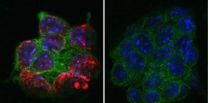(Press-News.org) Changes in ocean and climate systems could lead to smaller fish, according to a new study led by fisheries scientists at the University of British Columbia.
The study, published today in the journal Nature Climate Change, provides the first-ever global projection of the potential reduction in the maximum size of fish in a warmer and less-oxygenated ocean.
The researchers used computer modeling to study more than 600 species of fish from oceans around the world and found that the maximum body weight they can reach could decline by 14-20 per cent between years 2000 and 2050, with the tropics being one of the most impacted regions.
"We were surprised to see such a large decrease in fish size," says the study's lead author William Cheung, an assistant professor at the UBC Fisheries Centre. "Marine fish are generally known to respond to climate change through changing distribution and seasonality. But the unexpectedly big effect that climate change could have on body size suggests that we may be missing a big piece of the puzzle of understanding climate change effects in the ocean."
This is the first global-scale application of the idea that fish growth is limited by oxygen supply, which was pioneered more than 30 years ago by Daniel Pauly, principal investigator with UBC's Sea Around Us Project and the study's co-author.
"It's a constant challenge for fish to get enough oxygen from water to grow, and the situation gets worse as fish get bigger," explains Pauly. "A warmer and less-oxygenated ocean, as predicted under climate change, would make it more difficult for bigger fish to get enough oxygen, which means they will stop growing sooner."
This study highlights the need to curb greenhouse gas emissions and develop strategies to monitor and adapt to changes that we are already seeing, or we risk disruption of fisheries, food security and the way ocean ecosystems work.
### END
Fish getting smaller as the oceans warm: UBC research
2012-10-01
ELSE PRESS RELEASES FROM THIS DATE:
Researchers discover key mechanism for controlling the body's inflammatory response
2012-10-01
Researchers at Queen Mary, University of London have discovered how a key molecule controls the body's inflammatory responses. The molecule, known as p110delta, fine-tunes inflammation to avoid excessive reactions that can damage the organism. The findings, published in Nature Immunology today (30 September), could be exploited in vaccine development and new cancer therapies.
A healthy immune system reacts to danger signals – from microorganisms such as bacteria and viruses, or from the body's own rogue cells, such as cancer cells. This tightly controlled reaction starts ...
Researchers discover gene that causes deafness
2012-10-01
CINCINNATI—Researchers at the University of Cincinnati (UC) and Cincinnati Children's Hospital Medical Center have found a new genetic mutation responsible for deafness and hearing loss associated with Usher syndrome type 1.
These findings, published in the Sept. 30 advance online edition of the journal Nature Genetics, could help researchers develop new therapeutic targets for those at risk for this syndrome.
Partners in the study included the National Institute on Deafness and other Communication Disorders (NIDCD), Baylor College of Medicine and the University of ...
New pathogen epidemic identified in sub-Saharan Africa
2012-10-01
A new study out today (Sunday 30 September) reveals that the emergence and spread of a rapidly evolving invasive intestinal disease, that has a significant mortality rate (up to 45%) in infected people in sub-Saharan Africa, seems to have been potentiated by the HIV epidemic in Africa.
The team found that invasive non-Typhoidal Salmonella (iNTS) disease is caused by a new form of the bacteria Salmonella Typhimurium that has spread from two different focal hubs in Southern and Central Africa beginning 52 and 35 years ago, respectively. They also found that one of the ...
Climate change could cripple southwestern forests
2012-10-01
Combine the tree-ring growth record with historical information, climate records, and computer-model projections of future climate trends, and you get a grim picture for the future of trees in the southwestern United States. That's the word from a team of scientists from Los Alamos National Laboratory, the U.S. Geological Survey, the University of Arizona, and other partner organizations.
If the Southwest is warmer and drier in the near future, widespread tree death is likely and would cause substantial changes in the distribution of forests and of species, the researchers ...
Common RNA pathway found in ALS and dementia
2012-10-01
Two proteins previously found to contribute to ALS, also known as Lou Gehrig's disease, have divergent roles. But a new study, led by researchers at the Department of Cellular and Molecular Medicine at the University of California, San Diego School of Medicine, shows that a common pathway links them.
The discovery reveals a small set of target genes that could be used to measure the health of motor neurons, and provides a useful tool for development of new pharmaceuticals to treat the devastating disorder, which currently has no treatment or cure.
Funded in part by ...
The genetics of white finger disease
2012-10-01
Vibration-induced white finger disease (VWF) is caused by continued use of vibrating hand held machinery (high frequency vibration >50 Hz), and affects tens of thousands of people. New research published in BioMed Central's open access journal Clinical Epigenetics finds that people with a genetic polymorphism (A2191G) in sirtuin1 (SIRT1), a protein involved in the regulation of endothelial NOS (eNOS), are more likely to suffer from vibration-induced white finger disease.
VWF (also known as hand arm vibration syndrome (HAVS)) is a secondary form of Raynaud's disease involving ...
Breast cancer recurrence defined by hormone receptor status
2012-10-01
Human epidermal growth factor (HER2) positive breast cancers are often treated with the same therapy regardless of hormone receptor status. New research published in BioMed Central's open access journal Breast Cancer Research shows that women whose HER2 positive cancer was also hormone (estrogen and progesterone) receptor (HR) negative had an increased risk of early death, and that their cancer was less likely to recur in bone than those whose cancer retained hormone sensitivity.
Breast cancer is a heterogeneous disease with many different subtypes. HR positive cancer ...
Scientists find missing link between players in the epigenetic code
2012-10-01
CHAPEL HILL, N.C. – Over the last two decades, scientists have come to understand that the genetic code held within DNA represents only part of the blueprint of life. The rest comes from specific patterns of chemical tags that overlay the DNA structure, determining how tightly the DNA is packaged and how accessible certain genes are to be switched on or off.
As researchers have uncovered more and more of these "epigenetic" tags, they have begun to wonder how they are all connected. Now, research from the University of North Carolina School of Medicine has established ...
Blocking key protein could halt age-related decline in immune system, Stanford study finds
2012-10-01
STANFORD, Calif. — The older we get, the weaker our immune systems tend to become, leaving us vulnerable to infectious diseases and cancer and eroding our ability to benefit from vaccination. Now Stanford University School of Medicine scientists have found that blocking the action of a single protein whose levels in our immune cells creep steadily upward with age can restore those cells' response to a vaccine.
This discovery holds important long-term therapeutic ramifications, said Jorg Goronzy, MD, PhD, professor of rheumatology and immunology and the senior author of ...
Noninvasive measurement enables use of IFP as potential biomarker for tumor aggressiveness
2012-10-01
PHILADELPHIA — Researchers validated a method of noninvasive imaging that provides valuable information about interstitial fluid pressure of solid tumors and may aid in the identification of aggressive tumors, according to the results of a study published in Cancer Research, a journal of the American Association for Cancer Research.
Many malignant solid tumors generally develop a higher interstitial fluid pressure (IFP) than normal tissue. High IFP in tumors may cause a reduced uptake of chemotherapeutic agents and resistance to radiation therapy. In addition, a high ...


